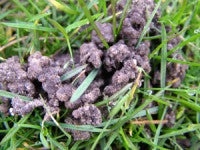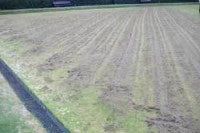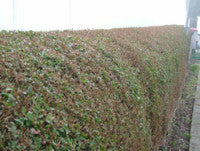Spring Maintenance of Bowling Greens 2006
Spring Maintenance of Bowling Greens
By David H Bates Agronomy Service.

The joys of spring soon come round each year. The Bowling Green fraternity, over 8000 registered clubs (5,000 flat greens and 3,500 crown greens) will soon be seen out practicing and playing on their bowling greens up and down the country. March will be a busy time for the many Green Keepers and Groundsmen who are responsible for maintaining these facilities. The onset of the playing season usually begins in March when favourable weather, soil and air temperatures begin rising above 10 degrees centigrade, thus encouraging and stimulating grass growth.
It is during March and early April that spring renovations are carried out to prepare the greens for the forthcoming playing season.
The main objective for the Groundsmen/Greenkeepers is to provide a consistent playing surface:-
- A bowling green should be of an even gradient without undulation, potholes or severe hollows or humps, which may deter the wood from the course as imparted by the bowler.
- The grass should be cut to a length which allows the wood to travel at a reasonable pace without undue effort or strain on the bowler.
- The bowl should travel at a good pace with accuracy.
- Water should shed quickly from the green.
- The grasses should be close knit with no bare patches.
- The grasses should contain desirable grass species.
- The surface should be firm and true with some give in it.
To achieve this there is a requirement for the Ground Staff to have a good sound knowledge of turf culture principles and practices, particularly in the timing of their execution.
It is essential that the Ground Staff have a basic understanding of the following practices:-
- Mowing
- Scarification
- Aeration
- Irrigation
- Renovation and Repair
- Overseeding
- Fertiliser Application
- Top Dressing
Spring Work Practices
These usually commence in late February or early March dependent on favourable weather conditions.
The first operation is to firm up the greens, particularly after a period of frosts when the ground has been lifted. This is carried out by rolling the green using your mower in the disengaged mode (no cylinder blades working) walking slowly in several directions over the surface of your green. 
Subsequent rolling can be carried out using a 50 kilo weight roller, better still a Sisis
Trulevel hand roller, again in many directions. Think of a clock face; the first run starting at 12 o'clock and finishing at 6 o'clock, then starting at 3 o'clock and finishing at 9 o'clock. Work around the clock to firm evenly when conditions allow, not when the soil is saturated or frosted. Ideally, perform this operation when the surface is drying out and the sub surface is moist. This will help firm the playing surface. The use of ride-on Turf Irons is now available. These specially designed turf rolling machines help to improve the speed of playing surfaces and allow the woods to roll smoothly across the green with less effort from the bowler.
A programme of surface aeration is beneficial, particularly to help drain away any surface water or address any surface compaction resulting from recent rolling activities. This can be achieved using a Sarrel Roller or a set of micro tines attached to a pedestrian mechanical spiker. Most of your deeper aeration works should have been completed during the winter months, i.e. November to February. Try to avoid the use of slit tines during the spring and summer as these types of aerators can lead to surface disruption, thus affecting surface playability. If you need to aerate during the playing season use solid tines.
Around March time, once growth has picked up, it may be essential to apply an application of lawn sand. This will help check any moss growth that has accumulated during the winter months. This treatment should be carried out prior to any scarification work being undertaken. The moss should either turn black in colour or be visibly dead prior to raking / scarification procedures.
A programme of light scarification works, using verti-cutting reels or dedicated scarifying machines set at a shallow depth, can be implemented in spring to remove any 
Daily brushing and switching of greens should continue to keep the greens clean and remove any early morning dew. Keeping the sward dry, particularly in the spring, helps prevent the likelihood and disease attacks. However, if you do get an outbreak of disease there are a number of professional fungicide products now available to help control or reduce the damaging effects of disease pathogens.
Worm activity will increase as the soil temperatures begin to rise and the soils remain moist. It may be necessary to apply an approved carbendazim based product to control worm activity.
Ideally, you should have carried out a soil analysis to establish the soil nutrient status and soil pH of your green. The results of this test will help you determine an effective fertiliser programme for the coming year..
Again, you should ideally have carried out a soil analysis to establish the soil nutrient status and soil pH of your green. The results of this test will help you determine an effective fertiliser programme for the coming year.
Mowing:
Mowing is one of the most important practices and should be carried out on a regular basis. Cutting frequencies will depend on the weather and ground conditions. During the playing season, March to October, the greens should be cut at least three times a week, if not daily. Mowing machines should be at least 7 to 9 bladed cylinder mowers that are kept well maintained and sharp. Height of cut will range from 3.5mm to 5mm during the playing season.
Mowing dictates:-
- The effect of the game.
- The health and appearance of a green.
- The standard of game played.

A by product of healthy grass growth is the build up of thatch layers (an accumulation of dead plant tissue and debris) that gradually builds up at the base of the grass plant. If left to accumulate it often becomes a problem, restricting and preventing air, light and water reaching the plant. Scarification is a mechanical operation used to remove this unwanted debris. In the past this material (thatch) was only ever removed during spring and autumn renovations. However, now with the invention of verti-cutting units / thatch reels, scarification can be carried out on a more regular basis (fortnightly), thus preventing thatch build up.
Aeration:
All grass swards are grown on soil / sand profiles that provide the appropriate environmental structure for plant growth. This growing medium, commonly known as soil, is made up of proportions of soil solids (minerals and organic material) and soil pores (water and air).
An example of the volume composition of a loam soil is represented in Figure 1.

Fig 1.
Maintaining the correct balance of these components is critical for sustaining healthy plant growth. The spaces between the particles of solid material are just as important to the nature of soil as are the solids themselves (Brady & Weil 2002). It is in these pore spaces that air and water circulate and help provide the plant with the necessary nutrients, air and water it requires to respire and grow.

Macro pores generally allow movement of air and the drainage of water and are large enough to accommodate plant roots and micro-organisms found in the soil. The ability to retain a good balance of macro pores in the soil structure is essential for maintaining grass plant health. It is when these macro pores are either reduced in size by compaction or filled with water that we see deterioration in pitch playability and resistance to wear.
However, the main contributing factor that reduces and damages pore spaces in soil is compaction caused by compression forces normally associated with play and use of machinery, particularly during wet weather periods. Over time these compression forces reduce the pore spaces so that air, water and nutrient flow through the soil profile is restricted, thus leading to many problems associated with compaction.
Aeration is the practice used to reintroduce air into the soil profile by mechanical means.
Fertiliser Applications:
To maintain optimum growing conditions for the grass plant a planned fertiliser programme should be implemented. Ideally, a soil analysis should have been carried out to ascertain the nutrient status of your soil. Once known, an effective NPK fertiliser programme can be applied to maximise plant growth.
Fertilisers now come in many forms, both granular and liquid. It is important that you understand how these products work and how to apply them. If in doubt leave it to a professional company to do it for you. Many greens are damaged and affected by poor fertiliser applications, using the wrong product or over or under dosing. This often leads to visual and physical problems on the surface.
Irrigation:
Most, if not all, professional sporting facilities have irrigation systems of one sort or another. Without them they would not be able to prepare and maintain their playing surfaces.
Irrigation is essential for a number of reasons:-
- For plant survival and growth.
- For soil formation.
- For soil strength.
- For chemical transport.
- For managing playability.
- For presentation.
Water is influential in all chemical, physiological and biological processes of plant growth. The soil / plant water relationships are critical to the sustainability of any grass plant. Having an understanding of these relationships is critical. All grass plants are a continuum of water movement. Over 90% of the plant's water requirements are transported through the plant from the soil profile, via the roots and stem tissues, into the leaves and out into the atmosphere. Knowledge of these relationships is important when designing and operating irrigation systems. The main aim is to achieve a water balance within the soil profile ensuring that the grass plant is able to access available water from the soil.
Therefore, it is essential that you water your greens during dry periods to sustain grass growth. Many clubs do have access to water and, in the main, probably keep their greens watered using a hose and sprinkler system. Care should be taken to ensure the green is watered uniformly and to adequate depth. Constant watering leads to shallow rooting.

Renovations are generally carried out at the end and beginning of the playing season, commonly known as end of season and spring renovations.
End of season renovations help rejuvenate the playing surface after a long hard season of wear and tear, with the main emphasis on restoring levels and re-populating grass species. It usually begins with a heavy scarification of the playing surface using a mechanical scarifier to remove thatch debris and provide a key for new root zone materials. Top dress with a compatible sand / soil dressing to restore levels, then overseed using an effective seed drill to ensure you have a good soil / seed contact to promote effective germination.
Once this work has been completed the green is usually fertilised with an autumn fertiliser product to help promote and sustain grass growth (when conditions allow) throughout the winter period.
Spring renovations are carried out to rejuvenate and prepare the green for the forthcoming season.
 Other Activities:
Other Activities:
Other than the main core activities mentioned above, there are often several other tasks or activities that can be implemented during the playing season. These will include keeping the surface clean and free of debris and other extraneous materials, possible use of wetting agents to prevent dry patch forming and help improve soil moisture contents.
- Keeping drainage ditches clean and safe.
- Maintaining hedges and boundary fence lines.
- Maintaining flood light columns and lights.
- Maintaining shelters and seating features around club house.
- Servicing mowers and machinery.
Annual Maintenance Programme: See Month by Month Guide Handout.
